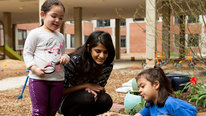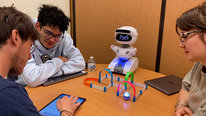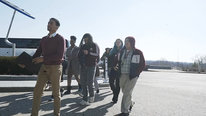- Kim Pearson
- https://www.linkedin.com/in/professorkim/
- Professor
- Presenter’s NSFRESOURCECENTERS
- The College of New Jersey
- Diane Bates
- https://sociology.tcnj.edu/faculty-profiles/dr-diane-bates/
- Professor
- Presenter’s NSFRESOURCECENTERS
- The College of New Jersey
- S. Monisha Pulimood
- https://pulimood.pages.tcnj.edu/
- Professor and Chair
- Presenter’s NSFRESOURCECENTERS
- The College of New Jersey
Collaborating Across Boundaries to En
NSF Awards: 1914869
2022 (see original presentation & discussion)
Undergraduate
Since Spring, 2020, participants in the Collaborating Across Boundaries to Engage Undergraduates in STEM Learning (NSF Award #1914869) have been testing a curricular model that seeks to boost STEM literacy through interdisciplinary teaching collaborations. We administrative and pedagogical interventions that have proved helpful in implementing these collaborations supplemented by preliminary data on the project outcomes.
Integrating STEM and CS, Research / Evaluation, Broadening Participation
TCNJ
Improving Undergraduate STEM Education (IUSE)
Related Content for Lessons learned: Preliminary results from the CAB project
-
 2022A pathway to technology literacy through art creation
2022A pathway to technology literacy through art creation
Raffaella Borasi
-
 2020CAB: Breaking Boundaries & Building Community to Boost STEM
2020CAB: Breaking Boundaries & Building Community to Boost STEM
Kim Pearson
-
 2022Linking Science with Eng and Math across Home and School
2022Linking Science with Eng and Math across Home and School
Ximena Dominguez
-
 2022Designing Innovative AI to Support K-12 Collaboration
2022Designing Innovative AI to Support K-12 Collaboration
Rachel Dickler
-
 2018Zip to STEM: Integrating Engineering Design in MS Science
2018Zip to STEM: Integrating Engineering Design in MS Science
Nidaa Makki
-
 2022Teacher Leaders: Hands-on STEM Lessons During the Pandemic
2022Teacher Leaders: Hands-on STEM Lessons During the Pandemic
Amanda Gunning
-
 2022GAMECHANGER: 30 Years of Diversifying the STEM Pipeline
2022GAMECHANGER: 30 Years of Diversifying the STEM Pipeline
Deb Cole
-
 2018STEM-Starter: STEM Capstone for High School
2018STEM-Starter: STEM Capstone for High School
Elizabeth Radday
This video has had approximately 201 visits by 158 visitors from 87 unique locations. It has been played 114 times as of 05/2023.
Map reflects activity with this presentation from the 2022 STEM For All Video Showcase website, as well as the STEM For All Multiplex website. 
Based on periodically updated Google Analytics data. This is intended to show usage trends but may not capture all activity from every visitor.
show more
Discussion from the 2022 STEM For All Video Showcase (13 posts)



Kim Pearson
Professor
Welcome!
Thank you for viewing our report on the third year of our Collaborating Across Boundaries project. Our project tests a curricular model for deepening TCNJ undergraduate STEM literacy by participating in interdisciplinary community-based collaborations. You can also view our 2021 and 2020 videos and discussion. The project is projected to conclude in 2023. By the time the project finishes, 17 faculty, more than 700 students and more than a dozen community partners will have participated in the project.
This year's video focuses on three of our current collaborations to highlight some of the emerging best practices from our project, based on preliminary survey and focus group data from participating students and faculty. Each faculty collaboration features in the video is focused on a specific practice:
Additional best practices that we have identified include:
More information
The following resources provide more detail on our preliminary outcomes, including some data on STEM literacy outcomes. More data and detail is forthcoming. Final outcomes will be available later in 2023 after the project concludes. In the meantime, we look forward to your feedback and questions!
Interactive story map about CAB teaching partnerships (2021-22 collaborations will be added soon.)
Justice Walker
Jay Labov
Currently STEM Education Consultant
Thank you for submitting this video. The range of projects in which The College of New Jersey (TCNJ) students collaborate with community partners to improve their learning and appreciation of the relevance of STEM is impressive! Your written comments about lessons learned thus far are also very helpful. Collaboration within departments is difficult. Collaboration across departments and with community partners can be even more challenging. Several other questions occurred to me as I watched the video and read your introductory remarks:
When I worked at the National Academies of Sciences, Engineering, and Medicine before retiring, I was involved with a project that tackled these issues that you, your colleagues, and other visitors to this video might find of interest (freely downloadable):
“The Integration of the Humanities and Arts with Sciences, Engineering, and Medicine in Higher Education: Branches from the Same Tree.” 2018. https://www.nap.edu/catalog/24988.
Thank you again!
Kim Pearson
Justice Walker
Kim Pearson
Professor
Thank you for your careful attention, and for the questions and link, which looks very interesting.
1. In answer to your first question, we didn't target faculty by discipline. We were constrained by the nature of our propagation model. The CAB model was based on a model two of the PIs developed in an earlier project, known as CABECT (NSF Award #1141170). The third PI had been an evaluator on the project, so she was also familiar with the model. Because the PIs were in Computer Science, Journalism, and Sociology, we each needed a collaborator in a complementary discipline. After the first semester, the initial six participating faculty found new collaborators, again in a complementary field. Until this year, we avoided first-year courses, because we wanted to engage students who were bringing some disciplinary knowledge. We also avoided recruiting untenured faculty. So those were the parameters, as opposed to the disciplines themselves.
2.Indeed, there are structural challenges when it comes to implementing this kind of collaboration across an institution. We do have an institutional culture that encourages faculty student collaboration as well as interdisciplinary collaboration. Generally, we've had support from our administration when it comes to faculty scheduling courses together and incorporating the "lab" section in our course registration and management system. We've been talking about how to institutionalize some of the practices that we've found successful in the CAB project.
3. Yes, the pandemic has had effects that we're still untangling. We went remote in the middle of Spring semester 2020, of course, and our meetings with our community partners have been fully remote ever since. We did publish a brief research note in the summer of 2020 in a special issue of Science Education and Civic Engagement: An International Journal. There were a few immediate effects on the design of our study. For example, one of our research questions had been to compare the possible impact of direct vs. indirect service on the project and student outcomes. Once the pandemic happened, direct service became impossible. Another immediate impact was we had to rethink collaborative meetings and team communication. Being forced to transition to remote learning did have a disparate impact on students with less access to high-speed internet, students who didn't have a quiet place to communicate or study at home, and students who had to share their computers with other family members. We also had students who became ill, and who had caregiving responsibilities. And we did see all of the emotional consequences that the pandemic has taken on all of us - the Zoom fatigue, for example.
On the other hand, having to go remote provided some advantages. We could bring all of our students and the community partner together without having to worry about finding a large enough space to hold everyone. (In some cases, the combined classes could mean having as many as 80 students involved at one time, especially when there were multiple sections of each class.) We could easily put students into breakout rooms to work on their team projects. Some teams used the challenge of working remotely to their advantage. For example, there was the team who collaborated with a high school in New Delhi, India. They are continuing to collaborate outside of the CAB project. For another project, students organized webinars about ways of improving media coverage of the experiences of vulnerable workers in New Jersey during the pandemic, complemented by their own ethnographic research. We do have some indication that being involved in a team project that was meaningful to real people outside of the college was motivational for some students. We also suspect that the ongoing pandemic stresses have continued to take an emotional toll. Some of our student researchers have been doing qualitative research interviews with students and community partners to gain further insights into theses stakeholders' feelings about the project, so we expect to learn more about the pandemic's impact.
Justice Walker
Kim Pearson
Professor
By the way, I realize I didn't answer your question about how we reach non-participants. We gave multiple presentations at campus forums and sponsored several programs of our own.
Justice Walker
Assistant Professor
This transdisciplinary project seems incredibly relevant today—when multiple perspectives and expertise are required to solve complex and often wicked problems! One of the features that stood out to me in this implementation is the focus on connecting with community and co-designing a project. This stood out in the video and, especially, in the project description you posted. I wondered if you would unpack a bit more about what (beyond prior relationships) goes into identifying collaborators and, more importantly, how you negotiated tensions that emerge when identifying research or objective priorities with diverse stakeholders. In other words, how to you negotiate (for instance) community health priorities that may not align with engineering priorities—were there processes you used to negotiate and emerge shared goals?
Also, it occurred to me that this looks a lot like a participatory design (or specifically codesign) approach—I wondered if you would share with others if you see this as consistent with your work and why you found this to be an important orientation for the work.
My sense is there are a number of other project PIs have sought to use more equitable and participatory approaches to enlisting diverse stakeholders in the development and design of research, teaching, etc—but few understand how or know where to start. Ultimately, I hoped you could share a bit about why interdisciplinary collaborations were important in this work as well as what best practices you might share for others interested in taking on collaborative research in a ways that empowers multiple stakeholders.
Thanks for pushing forward what seems to be a increasingly relevant form of research and teaching practice!
Kim Pearson
Professor
Thank you so much for your encouraging words and your questions. You're right that there's a definite commitment to designing solutions with community partners, as opposed to for them. The reason why we take this stance is related to the reason why we feel it's important that students learn how to collaborate in interdisciplinary teams. It all boils down to the fact that our problems are complex and multi-faceted. We know that teams of diverse problem-solvers produce better solutions because they are able to take more of these complexities into account. Community partners bring lots of relevant knowledge to the table, and our students learn a great deal from them.
As for where to start, I can respond to both from an individual faculty member's perspective, and from an institutional perspective. As a faculty member who has participated in CAB, I started with thinking about a specific course, the real-world problems that course is designed to address, and the kinds of collaborative and community-engaged learning experiences that will enhance their disciplinary knowledge. (It's important to note that our model assumes that faculty will implement our model in existing courses.) For example, as a journalism and professional writing teacher, I knew that I wanted my students to learn about ethnography - a skill that is becoming increasingly important in news organizations.. There's a kind of informal community of faculty who do community-engaged research and teaching, and I was fortunate that a colleague in our Anthropology program was willing to collaborate. she felt there would be value in her students learning more about journalism and how it is different from and similar to Anthropology. Our community partner was an organization that works with local newsrooms to help them better connect with the communities they serve.
As you note, there can tensions between the goals of the classes, the capabilities of the students, and the needs and capacities of the community partners. It's helpful if the faculty and community partner can talk through these questions at least a semester before. This is what happened in each of the collaborations featured in the video. In the Bates-Nelson and Chiang-DeGood collaborations in particular, the community partners were able to specify their needs and priorities in a way that helped the faculty partners think through the specific assignments they could include in their courses that would be useful to the project,
Every semester, we hold monthly meeting to check in with faculty about how their collaborations are going,. This is where we talk about challenges and share what's been working. We have built a repository of teaching resources that faculty members have found helpful - sample assignments, project descriptions, rubrics, informal and formal assessment instruments. We've been in conversation with our campus Center for Excellence in Teaching and Learning about how to institutionalize the practices of regular conversations about teaching, collaboration, and resource-sharing.
Kim Pearson
Justice Walker
Jay Labov
Currently STEM Education Consultant
Kim: Your statement that "...there's a definite commitment to designing solutions with community partners, as opposed to for them" is incredibly insightful and important for these kinds of efforts. Many years ago, I initiated a science education partnership between the college where I was a member of the biology faculty and four local school districts. The partnership focused on empowering teachers to become more effective in teaching science. I kept in my office a large sign that said "Outreach ≠ Partnership" as a constant reminder of what was really important in such collaborations.
Kim Pearson
Kim Pearson
Professor
Thanks, Jay. That's so important. I'm curious about what you learned from that experience and how it might have affected the way that you and your colleagues prepared preservice teachers in biology?
Jay Labov
Currently STEM Education Consultant
Our college didn't have a pre-service program for teachers in biology so we focused on working with in-service teachers. Here are examples about how we approached this project:
- As part of that admonition that I placed on the sign in my office, we asked teachers what they wanted to learn about and then set up activities to accommodate those interests rather than deciding ahead of time what we as a faculty would do to interact with teachers.
- We found funds to set up a science equipment lending library and commissioned a committee of local teachers to decide what kinds of equipment would be assist their effort. After our college faculty knew those preferences, we then worked with teachers to help select the most effective kinds of instruments and equipment.
- Our grants also paid for broken equipment to be replaced, for supplies to be replenished, and for teachers to be paid for the time they spent with college faculty and other teachers to learn how to use instruments and equipment that was unfamiliar to them.
Although now quite dated, this Powerpoint presentation that I developed provides a more details about the kinds of activities that were part of the Partnership. I'd be happy to engage in conversations after the Video Showcase closes with anyone who might want more information.
Anne Kern
Professor
The ability to collaborate and cooperate are enormous skills for preparation in the 21st century interdisciplinary workforce. Many STEM disciplines have recognized this with outcomes and professional standards that speak to this skill. Have you engaged in collaborative efforts with a community partner that is not within a “professional” institution, such as a Tribal or under-served community, where the project is based on that community’s needs and goals?
Justice Walker
Kim Pearson
Kim Pearson
Professor
Thank you for your comment and question. We've engaged a range of community partners and projects that fit those criteria. For example:
To conclude, we have always looked for opportunities to collaborate with partners with strong community representation and leadership, and our projects are always driven by needs identified by the community.
Justice Walker
Anne Kern
Professor
Hello Kim,
Thanks for replying to my comment. I guess I was actually wondering about the collaboration and partnership with a "less formal STEM" institution, such a Tribal community's Department of Natural Resources, or Community Youth Center, etc.?
Best,
Anne
Kim Pearson
Kim Pearson
Professor
Hi Anne,
I am sorry for misunderstanding your question. The collaboration with the local Girl Scouts troop on building solar suitcases fits that category. The TCNJ students also created updated content for the Scouts' environmental studies curriculum. Outside of CAB, we have a number of faculty involved in STEM related community-engaged learning projects, and we're hopeful that a CAB collaboration will emerge from that activity soon. This multidisciplinary collaboration with a group of Civil War re-enactors restoring a local African American cemetery is an example. The leader of the group is a retired biologist and the plans call for the placement of an environmental monitoring station on the site. This particular project just happened to evolve in a way that didn't fit our experimental model, so it's not included in the study.
As for Tribal communities, New Jersey is home to state-recognized indigenous communities: The Nanticoke Lenni-Lenape and the Ramapough Munsee Lenape Nation. Neither is near the campus. We have not established any CAB collaborations with either group, although it would be wonderful if that could happen.
Justice Walker
Further posting is closed as the event has ended.